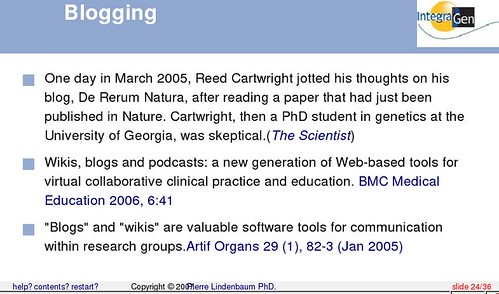// pubmed2connotea
// version 0.4 BETA!
// 2007-04-26
// Copyright (c) 2006, 2007, Pierre Lindenbaum PhD
// Released under the GPL license
//
http://www.gnu.org/copyleft/gpl.html//
http://www.integragen.com// --------------------------------------------------------------------
//
// This is a Greasemonkey user script. To install it, you need
// Greasemonkey 0.6.4 or later:
http://greasemonkey.mozdev.org/// and Firefox 1.5 :
http://www.mozilla.com/// Then restart Firefox and revisit this script.
// Under Tools, there will be a new menu item to "Install User Script".
// Accept the default configuration and install.
//
// To uninstall, go to Tools/Manage User Scripts,
// select "pubmed2connotea", and click Uninstall.
//
// 2006-07: changed for abstract-plus
// 2007-04: pubmed beta
//
// --------------------------------------------------------------------
// ==UserScript==
// @name pubmed2connotea
// @namespace
http://www.integragen.com// @description insert a shortcut link used to add an entry in
http://www.connotea.org or
http://www.citeulike.org/ when browsing NCBI pubmed
// @include
http://www.ncbi.nlm.nih.gov/entrez/*
// @include
http://www.ncbi.nlm.nih.gov/sites/*
// @include
http://www.ncbi.nlm.nih.gov/pubmed/*
// ==/UserScript==
function gm_xpath(expression,contextNode)
{
return document.evaluate(expression,contextNode,null,XPathResult.ORDERED_NODE_SNAPSHOT_TYPE,null);
}
function getParameter(url,parameter)
{
if(url==null) return null;
parameter=parameter.toLowerCase();
var a= url.indexOf("?");
if(a==-1) return null;
if(url.toLowerCase().indexOf(parameter+"=")==-1) return null;
var params= url.substring(a+1).split("&");
var i=0;
for(i=0;i<params.length;i++)
{
b= params[i].indexOf("=");
if(b==-1) continue;
var key = params[i].substring(0,b).toLowerCase();
if(key!=parameter) continue;
return params[i].substring(b+1);
}
return null;
}
function hasParameter(url,key,value)
{
var s= getParameter(url,key);
return (s!=null && s.toLowerCase() == value.toLowerCase() );
}
function escapeURL(url)
{
var s="";
var i=0;
for(i=0;i< url.length;++i)
{
var c=url.charAt(i)
switch( c )
{
case ':': s+= '%3A'; break;
case '/': s+= '%2F'; break;
case '?': s+= '%3F'; break;
case '=': s+= '%3D'; break;
case '&': s+= '%26'; break;
default : s+= c; break;
}
}
return s;
}
function insertAnchors()
{
if(document.getElementsByTagName)
{
//hack found at
http://erik.eae.net/archives/2005/06/10/22.21.42/#comment-5337
var inputElements = document.getElementsByTagName("input");
var i=0;
for (i=0; inputElements[i]!=null; i++)
{
inputElements[i].setAttribute("autocomplete","off");
}
}
}
var prefix="
http://www.ncbi.nlm.nih.gov/pubmed/";
var allAnchors = gm_xpath("//a[@href]",document);
var i=0;
var prev=0;
for(i=0; i<allAnchors.snapshotLength; i++)
{
a = allAnchors.snapshotItem(i);
if(a.parentNode==null) continue;
var href=a.href;
var index=href.indexOf(prefix);
var list_uids="null";
if(index==-1){
var templocation=href.indexOf("IdsFromResult");
if(templocation!=-1){
list_uids=getParameter(href,"IdsFromResult");
index=0;
}
}
if(index==-1) continue;
if(href.indexOf("id=Limits")!=-1||
href.indexOf("id=Preview/Index")!=-1||
href.indexOf("id=History")!=-1||
href.indexOf("id=Clipboard")!=-1||
href.indexOf("id=Details")!=-1||
href.indexOf("filter=review&")!=-1
) continue;
if(list_uids=="null"){
qlocation=href.indexOf("?");
if(qlocation!=-1){
list_uids=href.substring(35,qlocation);//pmid starts at 35
}
}
if(list_uids!=prev){
href= "
http://www.ncbi.nlm.nih.gov/entrez/query.fcgi?cmd=Retrieve&db=pubmed&dopt=Abstract&list_uids="+list_uids;
//href= "
http://www.ncbi.nlm.nih.gov/entrez/query.fcgi?cmd=Retrieve&db=pubmed&list_uids="+list_uids;
prev=list_uids;
var newanchor = document.createElement("a");
newanchor.setAttribute("title","insert into www.connotea.org");
newanchor.setAttribute("target","connotea"+i+list_uids);
//addpopup?continue=confirm
//newanchor.setAttribute("href","
http://www.connotea.org/addpopup?continue=confirm&uri="+escapeURL(href)+"&button=Look%20Up");
newanchor.setAttribute("href","
http://www.connotea.org/addpopup?continue=confirm&uri="+escapeURL(href));
var img = document.createElement("img");
img.setAttribute("alt","insert into www.connotea.org");
img.setAttribute("src","
http://www.connotea.org/connotea_icon.png");
img.setAttribute("border","0");
newanchor.appendChild(img);
//GM_log(a.href);
a.parentNode.insertBefore(newanchor,a);
a.parentNode.insertBefore(document.createTextNode(" "),a);
//now create link for citeulike
newanchor = document.createElement("a");
newanchor.setAttribute("title","insert into www.citeulike.org");
newanchor.setAttribute("target","citeulike"+i);
newanchor.setAttribute("href","
http://www.citeulike.org/posturl?url="+escapeURL(href)+"&title=Entrez%20PubMed");
img = document.createElement("img");
img.setAttribute("alt","insert into www.citeulike.org");
img.setAttribute("src","
http://static.citeulike.org/img/note.gif");
img.setAttribute("border","0");
newanchor.appendChild(img);
a.parentNode.insertBefore(newanchor,a);
a.parentNode.insertBefore(document.createTextNode(" "),a);
//now create link for del.icio.us
newanchor = document.createElement("a");
newanchor.setAttribute("title","insert into del.icio.us");
newanchor.setAttribute("target","delicious"+i);
newanchor.setAttribute("href","
http://del.icio.us/post?url="+escapeURL(href));
img = document.createElement("img");
img.setAttribute("alt","insert into del.icio.us");
img.setAttribute("src","
http://del.icio.us/favicon.ico");
img.setAttribute("border","0");
newanchor.appendChild(img);
a.parentNode.insertBefore(newanchor,a);
a.parentNode.insertBefore(document.createTextNode(" "),a);
}
}
window.addEventListener("load", insertAnchors, false);



